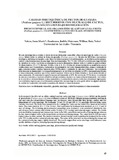| dc.rights.license | http://creativecommons.org/licenses/by-nc-sa/3.0/ve/ | es_VE |
| dc.contributor.author | Valera, Anne | |
| dc.contributor.author | Zambrano, Judith | |
| dc.contributor.author | Materano Aldana, Willian José | |
| dc.contributor.author | Ruiz, Yolexi | |
| dc.date.accessioned | 2019-06-06T18:54:10Z | |
| dc.date.available | 2019-06-06T18:54:10Z | |
| dc.date.issued | 2019-01 | |
| dc.identifier.issn | 1690 – 3226 | |
| dc.identifier.uri | http://www.saber.ula.ve/handle/123456789/45817 | |
| dc.description.abstract | En esta investigación se evaluó el efecto de un recubrimiento comestible a base de mucílago de cactus (Opuntia
elatior Miller) sobre la calidad de frutos de guayaba (Psidium guajava L). Un total de 300 frutos con madurez
fi siológica, uniformes en tamaño, color, libres de daños mecánicos y/o enfermedades, se dividieron en tres grupos:
control, y dos formulaciones de mucílago. Para los tratamientos T1 y T2 (10 y 20% p/v) se utilizó mucílago extraído
de cladodios de cactus. Los frutos se sumergieron en los recubrimientos durante 2min y el control en agua destilada.
Se almacenaron a 10 ± 1°C durante 16 días. A los 4, 8, 12 y 16 días de almacenamiento se analizaron cuatro
replicaciones por tratamiento, evaluándose los parámetros del color (luminosidad, hue, croma), contenido de
agua, relación solidos solubles totales/acidez (SST/acidez) y contenido de azúcares reductores. Los resultados
indicaron que la luminosidad y el croma fueron menores en los frutos recubiertos al 20% e incrementaron durante
el almacenamiento, mientras que el hue mostró mayores valores en los frutos tratados y decrecieron durante el
almacenamiento. El contenido de agua fue mayor en tratamiento al 20%. En la relación SST/acidez y el contenido
de azúcares reductores el análisis estadístico arrojó resultados similares en cuanto al factor tratamiento. Los valores
de la relación se elevaron durante el almacenamiento y el contenido de azúcares reductores disminuyó ligeramente.
Los resultados sugieren que el recubrimiento enriquecido con mucílago de cactus pudo infl uir en algunos atributos
de calidad de la guayaba, retrasando la maduración durante el almacenamiento. | es_VE |
| dc.language.iso | es | es_VE |
| dc.publisher | SaberULA | es_VE |
| dc.rights | info:eu-repo/semantics/openAccess | es_VE |
| dc.subject | Recubrimiento comestible | es_VE |
| dc.subject | Guayaba | es_VE |
| dc.subject | Mucílago | es_VE |
| dc.subject | calidad fisicoquímica y almacenamiento | es_VE |
| dc.title | Psidium guajava L.) Recubiertos con mucílago de cactus, almacenados bajo refrigeración | es_VE |
| dc.title.alternative | Physicochemical and organoleptic quality of guava fruits (psidium guajava l.) Coated with cactus mucilage, stored under refrigeration | es_VE |
| dc.type | info:eu-repo/semantics/article | es_VE |
| dc.description.abstract1 | In this research the effect of an edible coating based on cactus mucilage (Opuntia elatior Miller) on the quality
of guava fruits (Psidium guajava L) was evaluated. A total of 300 fruits with physiological maturity, uniform in
size and color, free of mechanical damages and / or diseases, were divided into three groups, control, and two
formulations of cactus mucilage. For treatments T1 and T2 (10 and 20% w / v), mucilage extracted from cactus
cladodes was used. The fruits were immersed in the coatings for 2 min and the control was inmersed in distilled
water. They were stored at 10 ± 1°C for 16 days. Four replications by treatment were analyzed, at 4, 8, 12 and 16
days of storage. The following physicochemical parameters were evaluated: color parameters (luminosity, hue
and chroma), water content, total soluble solids / acidity (TSS / acidity) and reducing sugars content. The results
indicated that the luminosity and chroma were lower in the 20% coated fruits and increased during storage, whereas
the hue showed higher values in the treated fruits and decreased during storage. The coated fruits at 20% presented
higher values in water content. The statistical analysis showed similar results regarding the treatment factor on the
ratio TSS / acidity and the content of reducing sugars. The values of the ratio were increased during the storage and
the content of reducing sugars slightly decreased. The results suggest that cactus mucilage could infl uence some
quality attributes of guava, delaying ripening during storage. | es_VE |
| dc.description.colacion | 49-58 | es_VE |
| dc.description.frecuencia | Semestral | |
| dc.identifier.depositolegal | pp 200202 TRI 298 | |
| dc.identifier.eissn | 2244 - 842X | |
| dc.publisher.pais | Venezuela | es_VE |
| dc.subject.institucion | Universidad de Los Andes | es_VE |
| dc.subject.keywords | Edible coating | es_VE |
| dc.subject.keywords | Guavas | es_VE |
| dc.subject.keywords | Mucilage | es_VE |
| dc.subject.keywords | Physicochemical quality and storage | es_VE |
| dc.subject.seccion | Revista Academia: Artículos de Investigación | es_VE |
| dc.subject.tipo | Artículos | es_VE |
| dc.type.media | Texto | es_VE |


